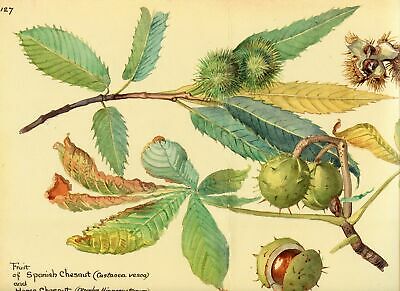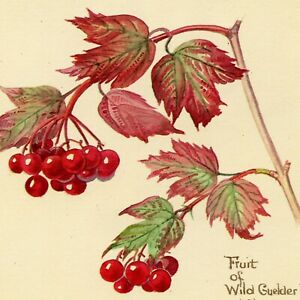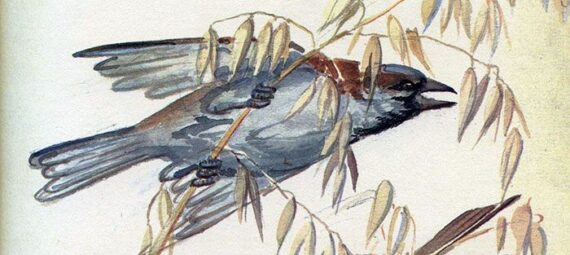 Edith Holden was born in 1871, and she died in 1920, She was an illustrator during what she herself labeled the Edwardian period. Anyone who loved the PBS series Downton Abbey will recall that the timeline of that series was also during the Edwardian period. Like several other ladies of that time, Edith painted what she saw in nature around her.
Edith Holden was born in 1871, and she died in 1920, She was an illustrator during what she herself labeled the Edwardian period. Anyone who loved the PBS series Downton Abbey will recall that the timeline of that series was also during the Edwardian period. Like several other ladies of that time, Edith painted what she saw in nature around her.
During her lifetime, she wrote Country Diary, Nature Notes of an Edwardian Lady, and some lesser works.

Beatrix Potter was born in England in 1868.

Edith Holden was born in England in 1871.
While Beatrix Potter’s reputation eclipsed Holden’s at that time, both Potter and Holden illustrated books for children.
In that she was a diarist, as well, as an illustrator, Edith Holden follows in the footsteps of Dorothy Wordsworth, who was the sister of the Romantic poet William Wordsworth. Dorothy was born in England in 1771 and she died in 1855.
Edith Holden’s most famous works are her illustrated nature journals, but while I am aware of a few verses that Holden wrote, most of her journals are filled with writings that she must have admired from other authors. In that her books were often compiled on a month-by-month basis, Holden’s books are in some ways like Almanacs that were popular while she was alive.
I’ve decided to share some of Holden’s work, month-by-month, one month at a time.
Following is what Edith ascribed to September in her book Country Diary of an Edwardian Lady:

“September was the seventh month of the old Roman year, but is the ninth month according to our reckoning. The Anglo-Saxons called it a ‘gest-month’ – Barley month.”
Feast Days
Sept. 21. St. Matthew
Sept. 29. St. Michael or Michaelmus Day
Plant trees at Michaelmus & command them to grow;
Set them at Candlemus & entreat them to grow.
“September blows soft, –
Til the fruits in the loft,
St. Matthew
Brings cold dew.”
“September dries up wells, or breaks down bridges.”
Country Diary, pg. 121.
:”Best I love September’s yellow,
Mourns of dew-strung gossamer,
Thoughtful days without a star,
Rooky clamours, brazen leaves,
Stubble dotted o’er with sheaves –
More than spring’s bright control,
But the autumn of my soul.” – Alex. Smith
The splendour falls on castle wallsAnd snowy summits old in story:The long light shakes across the lakes,And the wild cataract leaps in glory.Blow, bugle, blow, set the wild echoes flying,Blow, bugle; answer, echoes, dying, dying, dying.O hark, O hear! how thin and clear,And thinner, clearer, farther going!O sweet and far from cliff and scarThe horns of Elfland faintly blowing!Blow, let us hear the purple glens replying:Blow, bugle; answer, echoes, dying, dying, dying.
Country Diary, pg. 123.
Sept, 1, “Hottest day we have had here yet. This is the third day of bright sunshine. Cycled through Doune to to Dunbane, through well-wooded, rolling county, with low hills and fine, distant views. The road followed the windings of the Teith for a great part of the way. They have commenced harvesting in the old fields.
17. “Rowed to the top of Loch Vennachar and pic-niced on the shore. The Brake Fern on the hills is beginning to turn bronze and yellow. Great quantities of it have been cut and left to dry on the hillside, making great patches of red and brown. None of the trees are turning colour as yet. On the way home we witnessed a wonderful sunset across the water. The reflected light on the Eastern hilltop was gorgeous–al shades of gold and red and brown, deepening into purple and grey shades of grey shadows at the base of the mountains. There was a curious, gold-brown dust lying all over the surface of the loch, which we thought must be Heather pollen, blown across from the hills.

22. “Walked to the Lake of Monteith and back across the hills. Unlike most of the scotch lochs the shores are flat and marshy and surrounded by large beds of reeds, which are a great great resort of water-fowl of all kinds. The lake is noted for the number of large Pike it contains. The walls of the little inn-parlour on the edge of the lake are hung round with fine, stuffed specimens in cases, that have been captured in its waters.

“Rowed across to Inchamahone Priory, on one [Country Diary, pg. 125} of the two islands. Here were huge old Spanish Chesnut Trees, supposed to have been planted by the monks, and the largest Nut trees I have ever seen; also te Box tree, said to have been planted by Queen Mary. Most of the chesnut trees were green and vigorous with wonderful, twisted trunks and covered with fruit, as were the Nt trees.
The ruined walls of the Priory were green with the tiny Spleenwort; and Hare-bells were waving their purpled bells aloft from many of the top-most crevices. Crossing the high ridge of hills between the Teith Valley and the Menteith district we traversed some extensive peat-bogs. The colours of some of the mosses and bog plants were vivid the orange seed-vessels and of the … and deep crimson, and palest of the green mosses being particularly striking. The Heather is all turning brown now,–ony a pink bit here and there.
Sept. 25. “Goodbye to Scotland and back to the Midlands once more.
Sept. 30. “Scarcely any of the foliage on the trees is turned colour. Some of the Beech treees are quite bare, the leaves having shrivelled up and fallen off, this is doubtless due to the long drought there has been here.
Weather still continues perfect: Ho sun during the day, cold and clear at night, mist in the mornings.”
Country Diary, pg. 129.

September
“While ripening corn grew thick and deep,
And here and there men stood to reap,
One morn I put my heart to sleep,
Ans ro rhw meadows I took my way:
The goldfinch on a thistle-head
Stood scattering seedlets as she fed,
The wrens their pretty gossip spread,
Or joined a random roundelay.”
Jean Ingelow
Country Diary, pg. 130.
Following is what Edith ascribed to September in her book Nature Notes of an Edwardian Lady:
“September – the seventh month of the old Roman year. By the Julian arrangement, it became the ninth month, but still retained its former name.”
Feast Days
Sept. 8th – Nativity of the Blessed Virgin
Sept. 14th – The Exaltation of the Holy Cross
Sept. 21st – St. Matthew the Apostle
Sept. 29th – St. Michael the Archangel:(Michaelmus)
Plant trees at Michaelmus & command them to grow;
Set them at Candlemus & entreat them to grow.Go – bring me poppies – airy forms and slight,
Tethered to earth and drunk with sun and wind,
Gathered from gardens sown for sweet Delight,
Or graves where ruin sits with ampler mind.Bring scarlet down from Ceres’ heart
In young cornfields, wantonly o’er-run,
With hairy buds, whose separate sheathes dispart
O’er pensive banners, creased and silken-spunlBring large white globes that light the world of sleep
And yellow moons of some lone waste of sand
And set returning sail, and skim the deep
With such as grow in that southern land.
Poppies – E.M. Holden
Nature Notes, pg. 132
Go, for they call you, shepherd, from the hill;Go, shepherd, and untie the wattled cotes!No longer leave thy wistful flock unfed,Nor let thy bawling fellows rack their throats,Nor the cropp’d herbage shoot another head.But when the fields are still,And the tired men and dogs all gone to rest,And only the white sheep are sometimes seenCross and recross the strips of moon-blanch’d green,Come, shepherd, and again begin the quest!Here, where the reaper was at work of late—In this high field’s dark corner, where he leavesHis coat, his basket, and his earthen cruse,And in the sun all morning binds the sheaves,Then here, at noon, comes back his stores to use—Here will I sit and wait,While to my ear from uplands far awayThe bleating of the folded flocks is borne,With distant cries of reapers in the corn—All the live murmur of a summer’s day.
The Scholar-Gypsy Matthew Arnold

